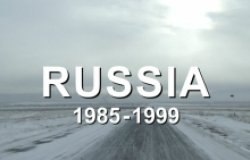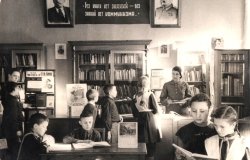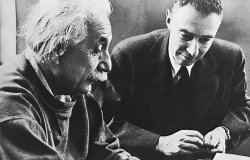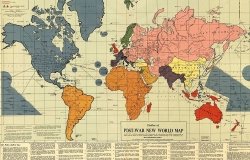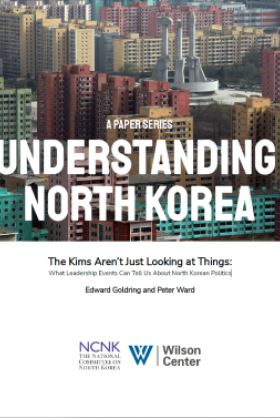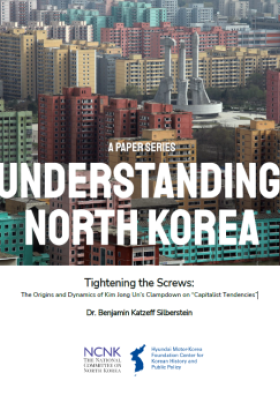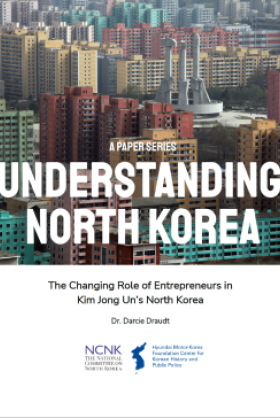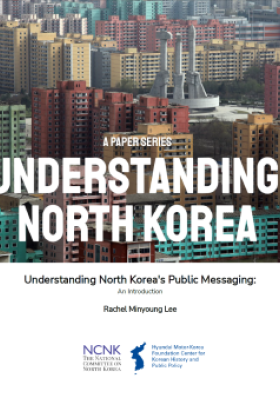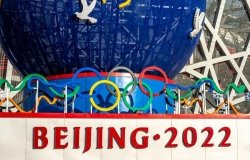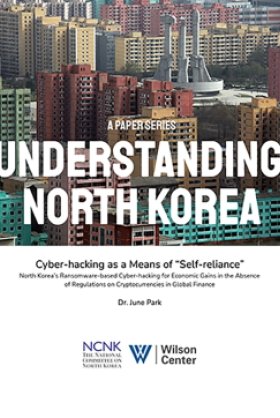319. The Albanian Experience of Communism in the Fiction of Ismail Kadare
John K. Cox is Associate Professor and Chair of History at Wheeling Jesuit University. He spoke at an EES Noon Discussion on February 25, 2005. The following is a summary of his presentation. Meeting Report 319.
In his 1978 novel The Great Winter, Ismail Kadare paints a chilling picture of a family that doctors its personal photo albums with ink to remove (most of) the faces and figures of people who have fallen out of favor with the Party of Labor. Readers might find themselves immediately reminded of Milan Kundera's great work from the same year, The Book of Laughter and Forgetting, in which the Czechoslovak party boss Klement Gottwald appears first in company, and then alone, on a balcony, wearing the hat of a colleague airbrushed from the photograph after his fall from grace. There is, indeed another novel that underscores these themes of manipulation and expendability: The Taste of Power (1967) by the Slovak writer and journalist Ladislav Mnacko, in which a "major retouching department" in the state press office tweaks photos and "rubs out" people who are now undesirable. That Stalin's regime made widespread use of tactics such as these has also been demonstrated by David King in his 1997 study The Commissar Vanishes. Kadare, an internationally famous, prolific and highly regarded author from Albania, has written a number of works about communism that show similarities to fiction from other East European countries and can be fruitfully examined in a comparative context. It is my assertion in this essay, however, that he also makes use of innovative and unique modes of writing about his homeland under the Hoxha dictatorship.
The renowned Albanian writer and public intellectual Ismail Kadare (b. 1936) has written a tremendous number of books on a wide variety of topics. Novels predominate in his oeuvre, followed by short stories and memoirs. Authors with whom he has been compared include Franz Kafka, Gabriel Garcia Marquez and Ivo Andric, though this observer also detects a certain amount of common ground with Jorge Luis Borges and William Faulkner. His main thematic concerns include Albania's experience under communism, the role of women in traditional societies, the nature of myth and mythmaking, the roots of the dispute over Kosovo/Kosova, the classical Greek heritage of today's Europe, the construction of the Albanian national identity, and the historical experience of the Balkan peoples in the Ottoman Empire. These are the thematic categories I use to analyze his writings in my forthcoming study entitled Understanding Ismail Kadare (University of South Carolina Press).
Nearly all of Kadare's works were either produced under the communist political system or could be seen to have some relevance to an understanding or critique of that system. The phrase "communist writings," however, I am applying to works that Kadare wrote—either during the time of communist rule in Albania or after—that treat the methods of rule, the ideology of the rulers and the effect of both of those things on the people of Albania. These numerous works do form a particular thematic preoccupation for him, although they vary widely in content and style. The modes in which Kadare writes about Albania under communism I shall call "socialist realist," "mythic" and "metaphoric."
Socialist realist mode
Kadare wrote works in the 1960s and 1970s that deserve the label of "socialist realism." What is most interesting about this phenomenon is that he never existed only in that mode. While producing such works may have tempered party criticism of his experimental inclinations, Kadare interspersed socialist realism with more irreverent or avant-garde texts. Study of his works also allows us to trace a very definite transformation of his ideas about communism in Albania; Kadare's views on authoritarianism mature, and not just in the complete freedom he found in Paris after 1990. His works that were banned or effectively removed from publication before the political changes of the period 1985-1990 evince either indifference to socialism (La ville sans enseignes; Le Monstre) or direct or indirect criticism of Albania's communist system or its rulers (Clair de Lune; The Palace of Dreams).
Among his mostly early and more or less straightforward works, The Wedding (1968), The November of a Capital (1975), The Great Winter (1977) and The Concert (1988) come the closest to garden-variety socialist realism. A well-written, if traditionally themed, short story in this vein is "The Winter Season in the Café Riviera" (1969); a characteristic novella is "Emblem from the Past" (1977). These works are not, however, without their poignant moments and they do not lack historical interest. The General of the Dead Army (1963), which propelled Kadare to fame, is arguably not fully Orthodox, above all in its steadfast refusal to exchange gloomy rain and Balkan belligerence for fair skies and radiant optimism about the future. In a similar vein, The Castle (1970) patently eschews an opportunity to make a hero of the valiant Scanderbeg; it thus contests Albanian leader Enver Hoxha's cult of personality. The early works La ville sans enseignes (1959) and Jours de beuverie (1962) celebrate the decadence and duplicity of youth and therefore attracted official opprobrium.
It is instructive to compare two of Kadare's texts about socialism in order to trace the trajectory of his thoughts. In the first, what one might term Katrina's "song of liberation" from The Wedding (1968), Kadare conclusively links the emancipation of women to the industrial transformation of Albania and the construction of a modern, unified national identity in the country. All three of these processes take place under the guidance of the Party of Labor, as the Albanian communist party was known. For Katrina, a young worker and bride, emancipation is a very concrete thing. It means not only liberation for patriarchy but literacy, technical training, a job in a different region of the country, train rides, an appreciation of the beauty and diversity of the country and its landscapes, solidarity with other young people, and even hot showers, clean underwear and radios. But tremendous conflicts surround this emancipation. As Katrina herself eloquently puts it, personifying the old order in the figure of the village intermediary (matchmaker) and, to some degree, her traditionalist father:
He wants to give me a half-lit nook and the
solitude of subjugation to a forty-year old man
I have never seen. He wants to deprive me of
my bobbed hair, clean underwear, wall
bulletins, books and songs, and in their place
to give me a black kettle, a lash rope to haul
firewood, filth, and beatings. He wants to
snatch away socialism from me.(178)
A very strong contrast is found in the novel La fille d'Agamemnon, written almost twenty years later in 1985. Here the protagonist, a misfit intellectual bemoaning the loss of his beloved, stands watching the downtown May Day parade and reflecting on the decades of political oppression and conformity.
And my heart cried out yet again: "My God,
deliver this country from dehumanization!
Protect it from any further fragmentation!!
For that which Asiatic torpor and dust
have not been able to do to it, the country
is now in the process of inflicting upon itself."
The large placards over the shoulders of
the jaded marchers in the rally were
sliding off to the left and right:
"LET US CONTINUE TO REVOLUTIONIZE LIFE!" and
"STUDY, PRODUCTIVE LABOR, MILITARY TRAINING!"...
Let us work, live, think as revolutionaries!
...Let us revolutionize all things...
How many years of such aridity
would be necessary to reduce life to a
field of rubble? And all because of the
simple reason that such blighting, such
shrivelling, would make life easier to control.
Temples pounding, I did not always
succeed in restraining the erratic course
of my thoughts. How the hell could one
revolutionize a woman's sex organs? For
if it is necessary to attack the foundations
of life, then this is where one would
have to begin...Correct its appearance, the
sombre delta that hangs over it, the moist
profile of the lips...Re-educate it by
depriving it of all the repercussions of
the past: orgasm, the thousands of
years of recollections of pleasure...
I would have burst out laughing if
I had not also felt so crushed.
The revolutionary triangle: study,
productive labor, military training...
And the black triangle of a woman's sex, what
will become of it? A crackled delta, prey
to desolation, topped by a few miserable
blades of yellow steppe grass? (127-129)
These passages focus specifically on communism's effect on women as a starting point for judging its positive and negative effects on the society as a whole. The emotional appeal of liberation and the trenchant nature of the final, roaming thoughts both have great impact on the reader, an impact that is heightened by their contrasting nature. The use of sexual imagery to typify a quest for authenticity and subjectivity that contrasts with ideology and the demands of politics or party life are major themes, as well, in the novel Spring Flowers, Spring Frost (2002) and the recent short story published in The New Yorker, "The Albanian Writer's Union as Mirrored by a Woman."
The mythic mode
This second mode bears certain similarities to the third, but because the myths are classical or folkloric, they can be distinguished from the more Orwellian or Kafkaesque metaphors in Kadare's Ottoman works.
The novel known as L'aigle (1995) is a sophisticated and enjoyable reflection on the toll that communist authoritarianism takes on its subjects. Like the longer and more complex novel Spiritus, the work embodies to some extent the approach—seen by Kadare as nearly a constant throughout literary history, and not a twentieth-century innovation—of magic realism. The two novels also share another key feature: seeking to generalize about the human costs of communism in a potent blend of classic or Illyrian myth and Albanian political realia. They also reflect the author's widely attested preoccupation with how legends and myths are formed, right into our own time.
This is the story of Max, a minor Albanian bank official who runs afoul—mildly—of the authorities and is punished by being "sent down" into a kind of alter-world exile. The tale is artfully constructed, so that the reader is never completely certain if the exile is vertical, into a new but parallel dimension, as Max's vague recollections of a long, starlit "fall" would have us believe, or whether his new town is simply a metaphor for exile in the isolated but largely familiar provinces of his native country.
The two other main characters in the book are the owner of the Liberty Bar, where much of the plot unfolds, and a woman named Anna, who is referred to as "annA," Max's love interest who shares a name with his girlfriend "up there," in the world from which he has been banished as punishment by the Party. One of Max's old friends crops up as well, having been "relegated" to this other world for, as one unnamed character identified only as "the man with the oblong face" says, "having talked too little or too much." This figure who formerly shared Max's existence "up there" is named Gazmend Hila, a college buddy who was riding in an elevator one day when the lights went out and it swished past the bottom floor of his building, kept dropping, and eventually deposited him in this town. Everyone "falls," we note, in a different way.
We also meet Dede Kola, a.k.a. Daedalus, and his son Ikanak, whose name evokes that of Icarus and is derived from the Albanian verb "ik," to flee or go away; Dede is building some marvelous machine in his studio, presumably to escape. There is also a reference to a writer named Skender Bermena, who also appears in other novels by Kadare (The Concert; The Great Winter); Bermena has been called an autobiographical figure, and this designation is supported here by the lack of clarity over whether he has been "sent away" to this place or is merely visiting as an observer.
Max determines to escape from his exile by flying back to Albania on a large and savage eagle. He obtains a packet of meat and a knife to fend off the powerful carnivore. A long flight sequence ensues, although the reader is ultimately not sure if it is real or hallucinatory. Max and the eagle fight and crash together. In the final scene of the book, the police are investigating a gory death at the local zoo. A man, Max, has been viciously attacked by an eagle, also now dead, although the actual cause of death was his own knife, not the eagle's beak or talons. The authorities can only reckon Max to have been a lunatic or an alcoholic
The metaphoric mode
In this third mode of writing, Kadare explores various events and systems that shed light on his own country. Works on the Ottoman Empire such as the novel The Palace of Dreams and numerous short stories such as "Caravan of Veils" and "Abolition of the Profession of Curser" demonstrate Kadare's interest in the mechanics of repression. Naturally they also represent his actual historical interest in how the Ottomans came to occupy his country, influencing its demography and culture so greatly, separating it from "Europe" for so long, and co-opting so many of its elites. But they were also oblique—if not oblique enough always to avoid censorship—ways of criticizing the rule of the Party of Labor of Albania.
The justifiably famous novel The Palace of Dreams has been called Kadare's most Kafkaesque and Orwellian work. It can be considered Orwellian because, like George Orwell's 1984, it examines the tyranny of a superstate. If we take alienation, anxiety, and absurdity, and throw in a good measure of feeling trapped and betrayed, and mix that up with nightmarishness, and violence, then we have a good starting point, of course, for comparisons to Kafka. It is, like The Castle, a Bildungsroman stood on its head.
The Palace of Dreams fits this bill. Specifically, its analysis of the tyrannical, or perhaps totalitarian, state works on five levels: domestic surveillance, terror, collaboration, anti-nationalism and power struggles within the elite. Many of these domains appear in Kadare's other Ottoman works, too.
Conclusion
In 1999, the British journalist Robert Carver published a description of his recent travels through postcommunist Albania entitled The Accursed Mountains: Journeys in Albania. Impressed by both the ruggedness of the terrain and the legacy of the paranoid dictator Enver Hoxha, Carver wrote:
Yet even in the wilderness, in the very
highest passes, perched on crags and
hidden in narrow valleys, there were
bunkers built by Hoxha. These and the
occasional enormous Socialist Realist concrete
statues of heroic partisans waving their
rifles from rocky eminences gave the
landscape a surreal quality, as though some
eccentric billionaire had commissioned
Christo and Salvador Dalí to create
a satirical Communist-Paranoid theme
park in this remote Balkan wilderness. (80)
While Kadare's works focus on far more than paranoia in the communist experience and are not gaudy or commercial like a theme park, this passage does remind us that it will indeed take bold artists like Kadare to create the new artistic landscapes that can heighten our understanding of the communist era. While Kadare has written about communism in various modes, the overall effect is to create a new language and set of symbols for understanding the communist era and putting it into historical perspective.
It remains to determine whether this taxonomy is useful in analyzing other works by Kadare on related themes; examples of such works include Le Crépuscule des dieux de la steppe (1981), L'Ombre (1994), and Vie, jeu et mort de Lul Mazrek (2002). The recently published translation of The Successor (2005) probably falls into the mythic mode examined above; this work, which has sparked a degree of indignation among Kadare's detractors, is not a departure but falls comfortably into a number of patterns in which the author has worked fruitfully for years. The indeterminate conclusion could actually reflect several intentions, such as the depiction of the sense of unreality and epistemological haze deliberately created by a truth-denying Stalinist regime.
About the Author
John K. Cox
Read More
Global Europe Program
The Global Europe Program is focused on Europe’s capabilities, and how it engages on critical global issues. We investigate European approaches to critical global issues. We examine Europe’s relations with Russia and Eurasia, China and the Indo-Pacific, the Middle East and Africa. Our initiatives include “Ukraine in Europe” – an examination of what it will take to make Ukraine’s European future a reality. But we also examine the role of NATO, the European Union and the OSCE, Europe’s energy security, transatlantic trade disputes, and challenges to democracy. The Global Europe Program’s staff, scholars-in-residence, and Global Fellows participate in seminars, policy study groups, and international conferences to provide analytical recommendations to policy makers and the media. Read more
